Cognitive Behavioural Therapy Assignment Report
VerifiedAdded on 2022/09/06
|11
|3018
|20
AI Summary
Contribute Materials
Your contribution can guide someone’s learning journey. Share your
documents today.
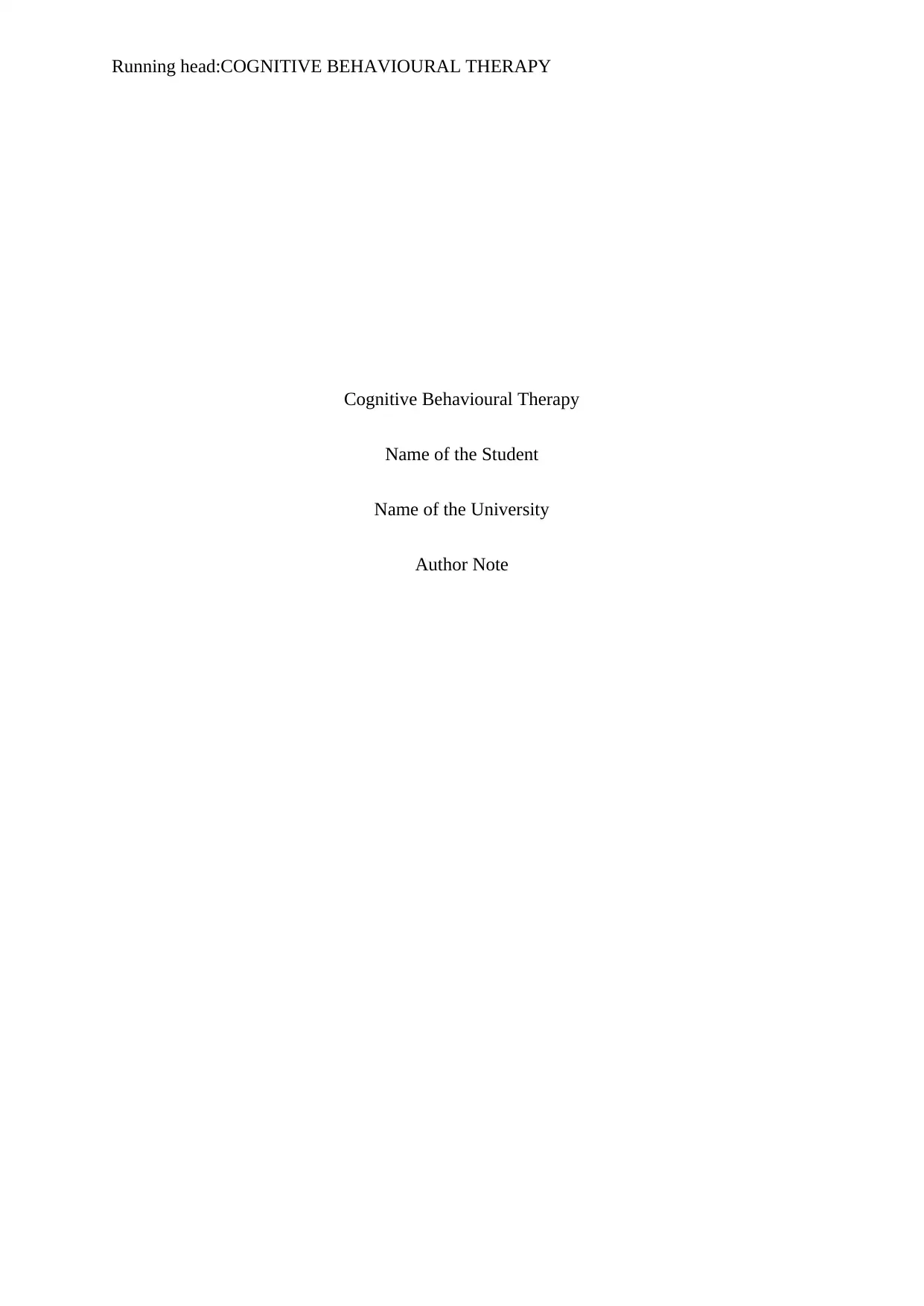
Running head:COGNITIVE BEHAVIOURAL THERAPY
Cognitive Behavioural Therapy
Name of the Student
Name of the University
Author Note
Cognitive Behavioural Therapy
Name of the Student
Name of the University
Author Note
Secure Best Marks with AI Grader
Need help grading? Try our AI Grader for instant feedback on your assignments.
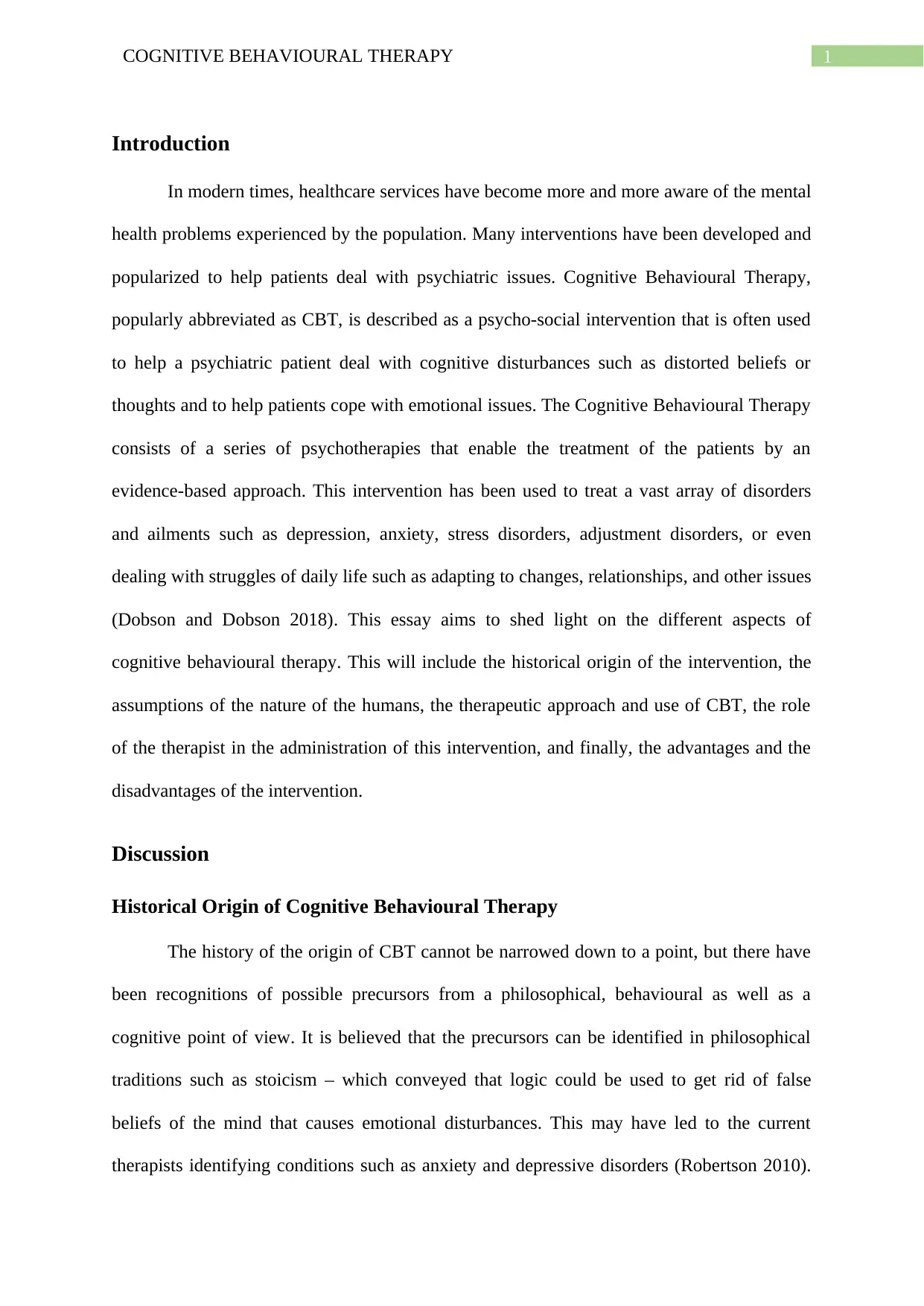
1COGNITIVE BEHAVIOURAL THERAPY
Introduction
In modern times, healthcare services have become more and more aware of the mental
health problems experienced by the population. Many interventions have been developed and
popularized to help patients deal with psychiatric issues. Cognitive Behavioural Therapy,
popularly abbreviated as CBT, is described as a psycho-social intervention that is often used
to help a psychiatric patient deal with cognitive disturbances such as distorted beliefs or
thoughts and to help patients cope with emotional issues. The Cognitive Behavioural Therapy
consists of a series of psychotherapies that enable the treatment of the patients by an
evidence-based approach. This intervention has been used to treat a vast array of disorders
and ailments such as depression, anxiety, stress disorders, adjustment disorders, or even
dealing with struggles of daily life such as adapting to changes, relationships, and other issues
(Dobson and Dobson 2018). This essay aims to shed light on the different aspects of
cognitive behavioural therapy. This will include the historical origin of the intervention, the
assumptions of the nature of the humans, the therapeutic approach and use of CBT, the role
of the therapist in the administration of this intervention, and finally, the advantages and the
disadvantages of the intervention.
Discussion
Historical Origin of Cognitive Behavioural Therapy
The history of the origin of CBT cannot be narrowed down to a point, but there have
been recognitions of possible precursors from a philosophical, behavioural as well as a
cognitive point of view. It is believed that the precursors can be identified in philosophical
traditions such as stoicism – which conveyed that logic could be used to get rid of false
beliefs of the mind that causes emotional disturbances. This may have led to the current
therapists identifying conditions such as anxiety and depressive disorders (Robertson 2010).
Introduction
In modern times, healthcare services have become more and more aware of the mental
health problems experienced by the population. Many interventions have been developed and
popularized to help patients deal with psychiatric issues. Cognitive Behavioural Therapy,
popularly abbreviated as CBT, is described as a psycho-social intervention that is often used
to help a psychiatric patient deal with cognitive disturbances such as distorted beliefs or
thoughts and to help patients cope with emotional issues. The Cognitive Behavioural Therapy
consists of a series of psychotherapies that enable the treatment of the patients by an
evidence-based approach. This intervention has been used to treat a vast array of disorders
and ailments such as depression, anxiety, stress disorders, adjustment disorders, or even
dealing with struggles of daily life such as adapting to changes, relationships, and other issues
(Dobson and Dobson 2018). This essay aims to shed light on the different aspects of
cognitive behavioural therapy. This will include the historical origin of the intervention, the
assumptions of the nature of the humans, the therapeutic approach and use of CBT, the role
of the therapist in the administration of this intervention, and finally, the advantages and the
disadvantages of the intervention.
Discussion
Historical Origin of Cognitive Behavioural Therapy
The history of the origin of CBT cannot be narrowed down to a point, but there have
been recognitions of possible precursors from a philosophical, behavioural as well as a
cognitive point of view. It is believed that the precursors can be identified in philosophical
traditions such as stoicism – which conveyed that logic could be used to get rid of false
beliefs of the mind that causes emotional disturbances. This may have led to the current
therapists identifying conditions such as anxiety and depressive disorders (Robertson 2010).
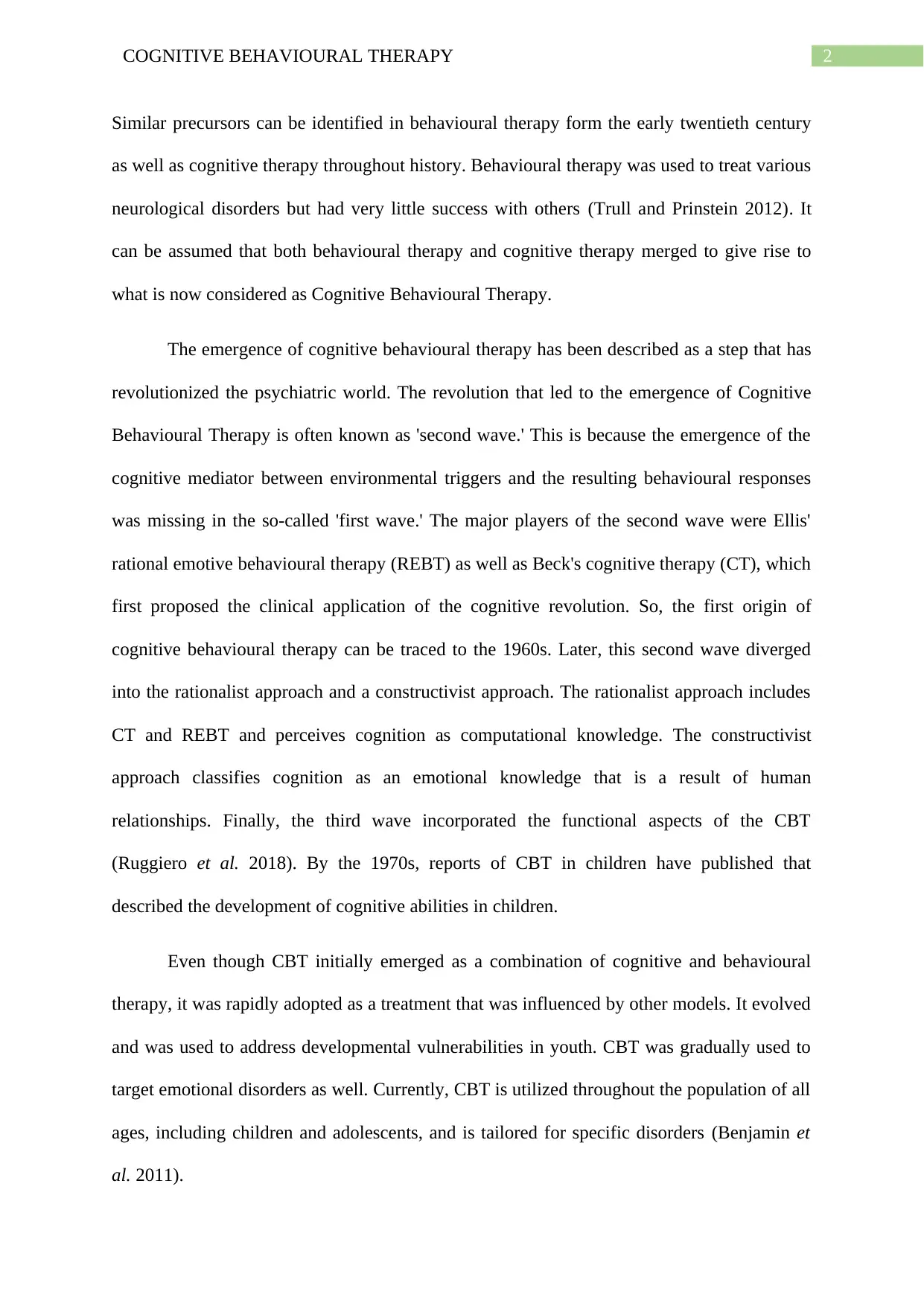
2COGNITIVE BEHAVIOURAL THERAPY
Similar precursors can be identified in behavioural therapy form the early twentieth century
as well as cognitive therapy throughout history. Behavioural therapy was used to treat various
neurological disorders but had very little success with others (Trull and Prinstein 2012). It
can be assumed that both behavioural therapy and cognitive therapy merged to give rise to
what is now considered as Cognitive Behavioural Therapy.
The emergence of cognitive behavioural therapy has been described as a step that has
revolutionized the psychiatric world. The revolution that led to the emergence of Cognitive
Behavioural Therapy is often known as 'second wave.' This is because the emergence of the
cognitive mediator between environmental triggers and the resulting behavioural responses
was missing in the so-called 'first wave.' The major players of the second wave were Ellis'
rational emotive behavioural therapy (REBT) as well as Beck's cognitive therapy (CT), which
first proposed the clinical application of the cognitive revolution. So, the first origin of
cognitive behavioural therapy can be traced to the 1960s. Later, this second wave diverged
into the rationalist approach and a constructivist approach. The rationalist approach includes
CT and REBT and perceives cognition as computational knowledge. The constructivist
approach classifies cognition as an emotional knowledge that is a result of human
relationships. Finally, the third wave incorporated the functional aspects of the CBT
(Ruggiero et al. 2018). By the 1970s, reports of CBT in children have published that
described the development of cognitive abilities in children.
Even though CBT initially emerged as a combination of cognitive and behavioural
therapy, it was rapidly adopted as a treatment that was influenced by other models. It evolved
and was used to address developmental vulnerabilities in youth. CBT was gradually used to
target emotional disorders as well. Currently, CBT is utilized throughout the population of all
ages, including children and adolescents, and is tailored for specific disorders (Benjamin et
al. 2011).
Similar precursors can be identified in behavioural therapy form the early twentieth century
as well as cognitive therapy throughout history. Behavioural therapy was used to treat various
neurological disorders but had very little success with others (Trull and Prinstein 2012). It
can be assumed that both behavioural therapy and cognitive therapy merged to give rise to
what is now considered as Cognitive Behavioural Therapy.
The emergence of cognitive behavioural therapy has been described as a step that has
revolutionized the psychiatric world. The revolution that led to the emergence of Cognitive
Behavioural Therapy is often known as 'second wave.' This is because the emergence of the
cognitive mediator between environmental triggers and the resulting behavioural responses
was missing in the so-called 'first wave.' The major players of the second wave were Ellis'
rational emotive behavioural therapy (REBT) as well as Beck's cognitive therapy (CT), which
first proposed the clinical application of the cognitive revolution. So, the first origin of
cognitive behavioural therapy can be traced to the 1960s. Later, this second wave diverged
into the rationalist approach and a constructivist approach. The rationalist approach includes
CT and REBT and perceives cognition as computational knowledge. The constructivist
approach classifies cognition as an emotional knowledge that is a result of human
relationships. Finally, the third wave incorporated the functional aspects of the CBT
(Ruggiero et al. 2018). By the 1970s, reports of CBT in children have published that
described the development of cognitive abilities in children.
Even though CBT initially emerged as a combination of cognitive and behavioural
therapy, it was rapidly adopted as a treatment that was influenced by other models. It evolved
and was used to address developmental vulnerabilities in youth. CBT was gradually used to
target emotional disorders as well. Currently, CBT is utilized throughout the population of all
ages, including children and adolescents, and is tailored for specific disorders (Benjamin et
al. 2011).
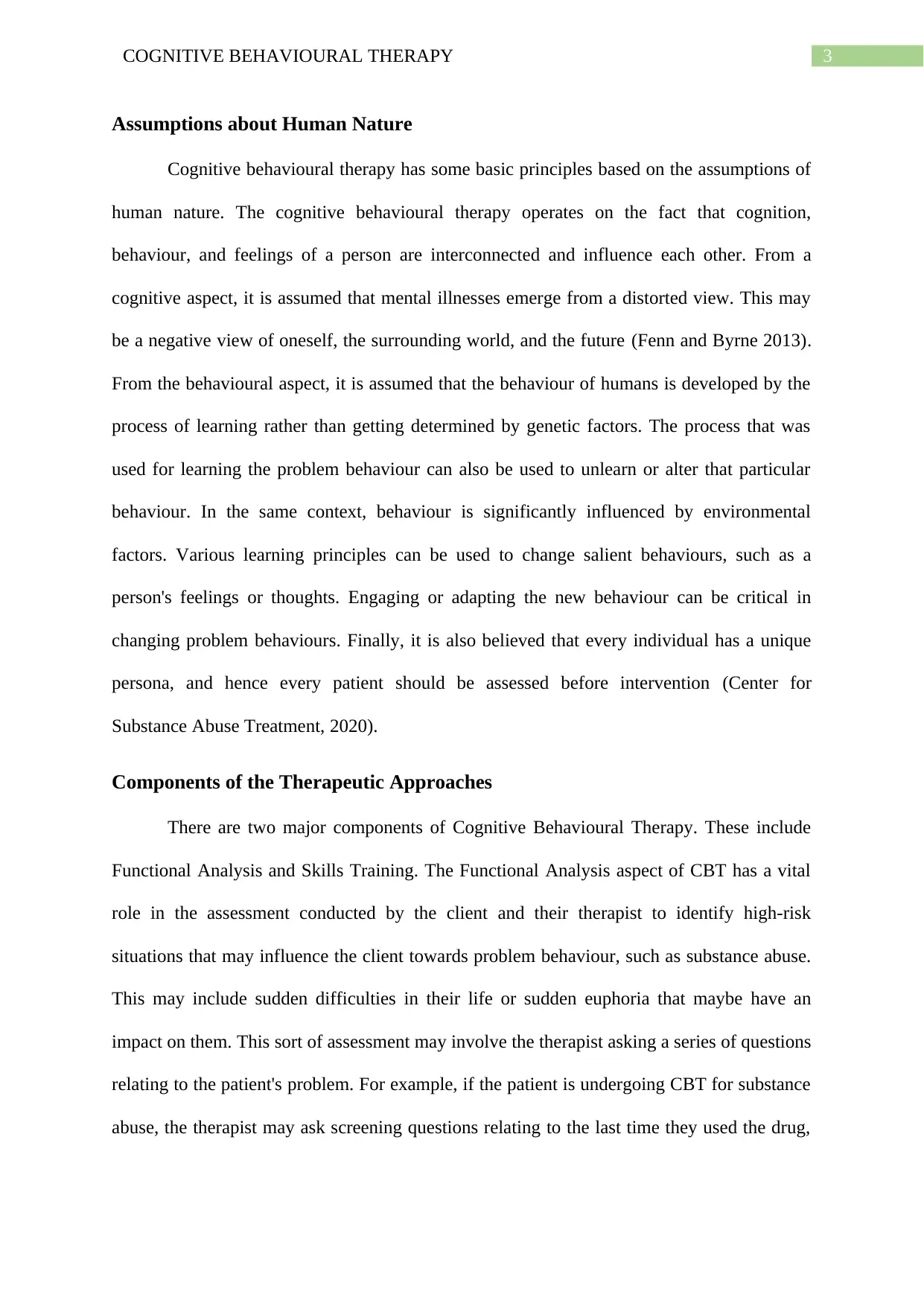
3COGNITIVE BEHAVIOURAL THERAPY
Assumptions about Human Nature
Cognitive behavioural therapy has some basic principles based on the assumptions of
human nature. The cognitive behavioural therapy operates on the fact that cognition,
behaviour, and feelings of a person are interconnected and influence each other. From a
cognitive aspect, it is assumed that mental illnesses emerge from a distorted view. This may
be a negative view of oneself, the surrounding world, and the future (Fenn and Byrne 2013).
From the behavioural aspect, it is assumed that the behaviour of humans is developed by the
process of learning rather than getting determined by genetic factors. The process that was
used for learning the problem behaviour can also be used to unlearn or alter that particular
behaviour. In the same context, behaviour is significantly influenced by environmental
factors. Various learning principles can be used to change salient behaviours, such as a
person's feelings or thoughts. Engaging or adapting the new behaviour can be critical in
changing problem behaviours. Finally, it is also believed that every individual has a unique
persona, and hence every patient should be assessed before intervention (Center for
Substance Abuse Treatment, 2020).
Components of the Therapeutic Approaches
There are two major components of Cognitive Behavioural Therapy. These include
Functional Analysis and Skills Training. The Functional Analysis aspect of CBT has a vital
role in the assessment conducted by the client and their therapist to identify high-risk
situations that may influence the client towards problem behaviour, such as substance abuse.
This may include sudden difficulties in their life or sudden euphoria that maybe have an
impact on them. This sort of assessment may involve the therapist asking a series of questions
relating to the patient's problem. For example, if the patient is undergoing CBT for substance
abuse, the therapist may ask screening questions relating to the last time they used the drug,
Assumptions about Human Nature
Cognitive behavioural therapy has some basic principles based on the assumptions of
human nature. The cognitive behavioural therapy operates on the fact that cognition,
behaviour, and feelings of a person are interconnected and influence each other. From a
cognitive aspect, it is assumed that mental illnesses emerge from a distorted view. This may
be a negative view of oneself, the surrounding world, and the future (Fenn and Byrne 2013).
From the behavioural aspect, it is assumed that the behaviour of humans is developed by the
process of learning rather than getting determined by genetic factors. The process that was
used for learning the problem behaviour can also be used to unlearn or alter that particular
behaviour. In the same context, behaviour is significantly influenced by environmental
factors. Various learning principles can be used to change salient behaviours, such as a
person's feelings or thoughts. Engaging or adapting the new behaviour can be critical in
changing problem behaviours. Finally, it is also believed that every individual has a unique
persona, and hence every patient should be assessed before intervention (Center for
Substance Abuse Treatment, 2020).
Components of the Therapeutic Approaches
There are two major components of Cognitive Behavioural Therapy. These include
Functional Analysis and Skills Training. The Functional Analysis aspect of CBT has a vital
role in the assessment conducted by the client and their therapist to identify high-risk
situations that may influence the client towards problem behaviour, such as substance abuse.
This may include sudden difficulties in their life or sudden euphoria that maybe have an
impact on them. This sort of assessment may involve the therapist asking a series of questions
relating to the patient's problem. For example, if the patient is undergoing CBT for substance
abuse, the therapist may ask screening questions relating to the last time they used the drug,
Secure Best Marks with AI Grader
Need help grading? Try our AI Grader for instant feedback on your assignments.
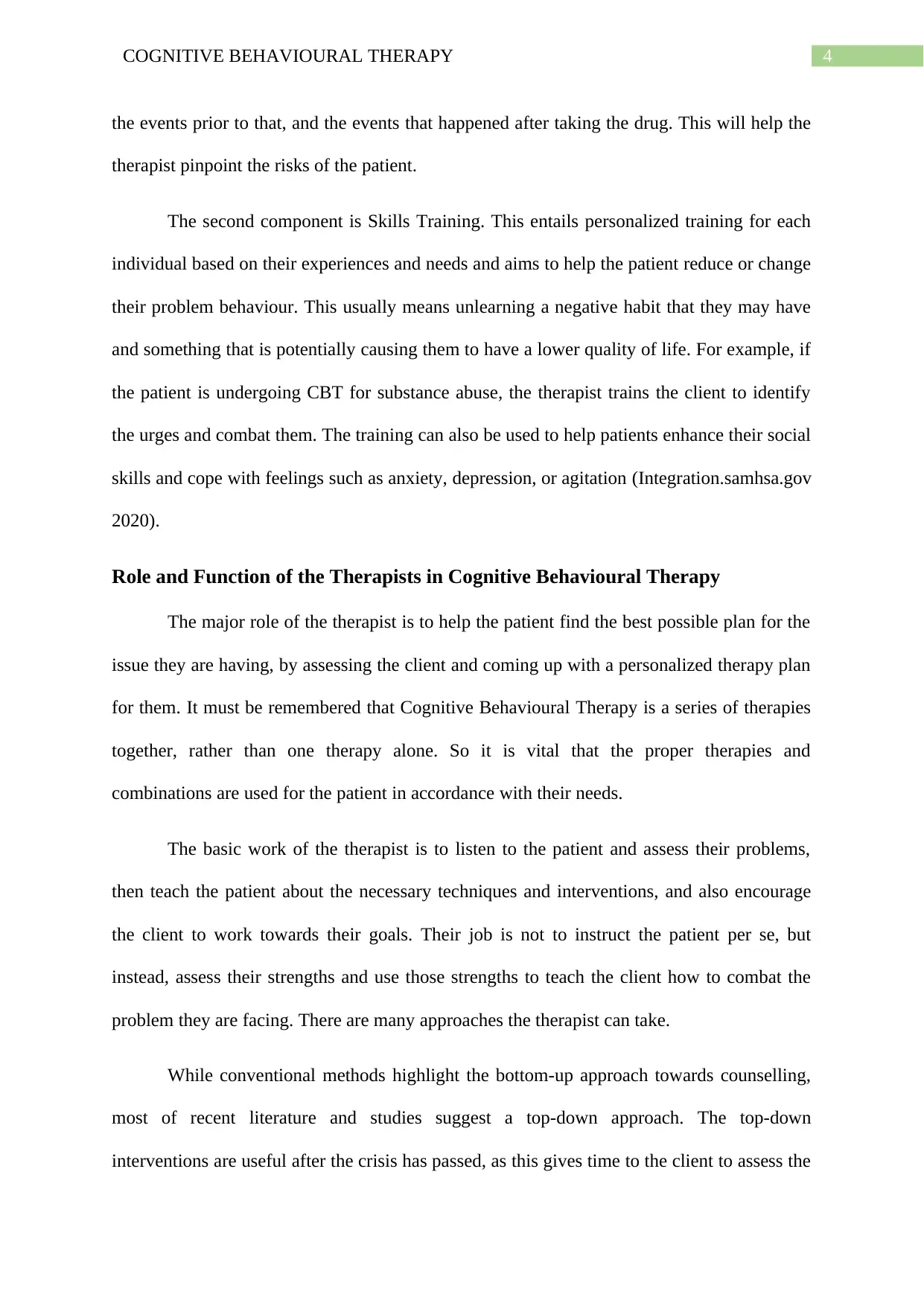
4COGNITIVE BEHAVIOURAL THERAPY
the events prior to that, and the events that happened after taking the drug. This will help the
therapist pinpoint the risks of the patient.
The second component is Skills Training. This entails personalized training for each
individual based on their experiences and needs and aims to help the patient reduce or change
their problem behaviour. This usually means unlearning a negative habit that they may have
and something that is potentially causing them to have a lower quality of life. For example, if
the patient is undergoing CBT for substance abuse, the therapist trains the client to identify
the urges and combat them. The training can also be used to help patients enhance their social
skills and cope with feelings such as anxiety, depression, or agitation (Integration.samhsa.gov
2020).
Role and Function of the Therapists in Cognitive Behavioural Therapy
The major role of the therapist is to help the patient find the best possible plan for the
issue they are having, by assessing the client and coming up with a personalized therapy plan
for them. It must be remembered that Cognitive Behavioural Therapy is a series of therapies
together, rather than one therapy alone. So it is vital that the proper therapies and
combinations are used for the patient in accordance with their needs.
The basic work of the therapist is to listen to the patient and assess their problems,
then teach the patient about the necessary techniques and interventions, and also encourage
the client to work towards their goals. Their job is not to instruct the patient per se, but
instead, assess their strengths and use those strengths to teach the client how to combat the
problem they are facing. There are many approaches the therapist can take.
While conventional methods highlight the bottom-up approach towards counselling,
most of recent literature and studies suggest a top-down approach. The top-down
interventions are useful after the crisis has passed, as this gives time to the client to assess the
the events prior to that, and the events that happened after taking the drug. This will help the
therapist pinpoint the risks of the patient.
The second component is Skills Training. This entails personalized training for each
individual based on their experiences and needs and aims to help the patient reduce or change
their problem behaviour. This usually means unlearning a negative habit that they may have
and something that is potentially causing them to have a lower quality of life. For example, if
the patient is undergoing CBT for substance abuse, the therapist trains the client to identify
the urges and combat them. The training can also be used to help patients enhance their social
skills and cope with feelings such as anxiety, depression, or agitation (Integration.samhsa.gov
2020).
Role and Function of the Therapists in Cognitive Behavioural Therapy
The major role of the therapist is to help the patient find the best possible plan for the
issue they are having, by assessing the client and coming up with a personalized therapy plan
for them. It must be remembered that Cognitive Behavioural Therapy is a series of therapies
together, rather than one therapy alone. So it is vital that the proper therapies and
combinations are used for the patient in accordance with their needs.
The basic work of the therapist is to listen to the patient and assess their problems,
then teach the patient about the necessary techniques and interventions, and also encourage
the client to work towards their goals. Their job is not to instruct the patient per se, but
instead, assess their strengths and use those strengths to teach the client how to combat the
problem they are facing. There are many approaches the therapist can take.
While conventional methods highlight the bottom-up approach towards counselling,
most of recent literature and studies suggest a top-down approach. The top-down
interventions are useful after the crisis has passed, as this gives time to the client to assess the
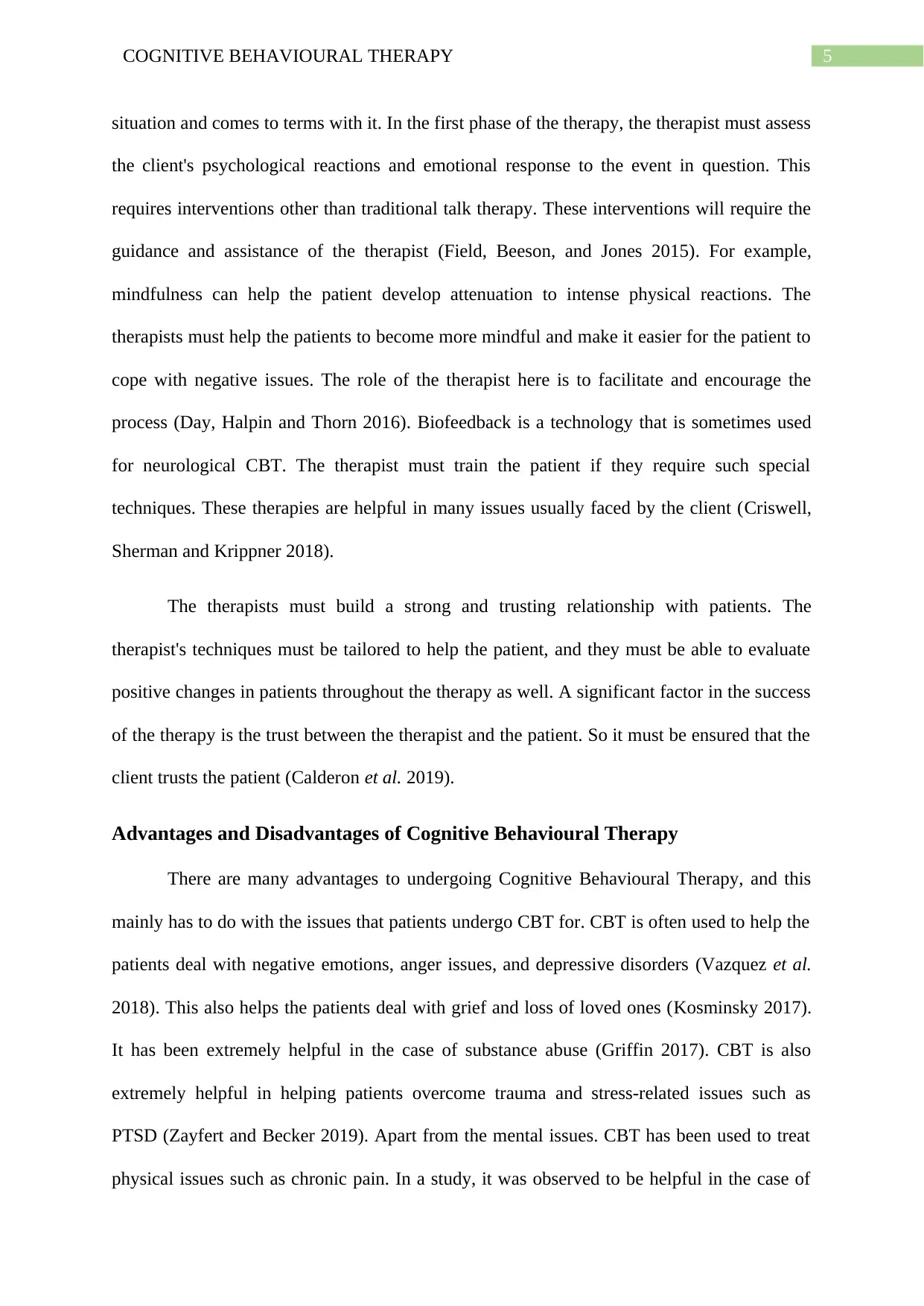
5COGNITIVE BEHAVIOURAL THERAPY
situation and comes to terms with it. In the first phase of the therapy, the therapist must assess
the client's psychological reactions and emotional response to the event in question. This
requires interventions other than traditional talk therapy. These interventions will require the
guidance and assistance of the therapist (Field, Beeson, and Jones 2015). For example,
mindfulness can help the patient develop attenuation to intense physical reactions. The
therapists must help the patients to become more mindful and make it easier for the patient to
cope with negative issues. The role of the therapist here is to facilitate and encourage the
process (Day, Halpin and Thorn 2016). Biofeedback is a technology that is sometimes used
for neurological CBT. The therapist must train the patient if they require such special
techniques. These therapies are helpful in many issues usually faced by the client (Criswell,
Sherman and Krippner 2018).
The therapists must build a strong and trusting relationship with patients. The
therapist's techniques must be tailored to help the patient, and they must be able to evaluate
positive changes in patients throughout the therapy as well. A significant factor in the success
of the therapy is the trust between the therapist and the patient. So it must be ensured that the
client trusts the patient (Calderon et al. 2019).
Advantages and Disadvantages of Cognitive Behavioural Therapy
There are many advantages to undergoing Cognitive Behavioural Therapy, and this
mainly has to do with the issues that patients undergo CBT for. CBT is often used to help the
patients deal with negative emotions, anger issues, and depressive disorders (Vazquez et al.
2018). This also helps the patients deal with grief and loss of loved ones (Kosminsky 2017).
It has been extremely helpful in the case of substance abuse (Griffin 2017). CBT is also
extremely helpful in helping patients overcome trauma and stress-related issues such as
PTSD (Zayfert and Becker 2019). Apart from the mental issues. CBT has been used to treat
physical issues such as chronic pain. In a study, it was observed to be helpful in the case of
situation and comes to terms with it. In the first phase of the therapy, the therapist must assess
the client's psychological reactions and emotional response to the event in question. This
requires interventions other than traditional talk therapy. These interventions will require the
guidance and assistance of the therapist (Field, Beeson, and Jones 2015). For example,
mindfulness can help the patient develop attenuation to intense physical reactions. The
therapists must help the patients to become more mindful and make it easier for the patient to
cope with negative issues. The role of the therapist here is to facilitate and encourage the
process (Day, Halpin and Thorn 2016). Biofeedback is a technology that is sometimes used
for neurological CBT. The therapist must train the patient if they require such special
techniques. These therapies are helpful in many issues usually faced by the client (Criswell,
Sherman and Krippner 2018).
The therapists must build a strong and trusting relationship with patients. The
therapist's techniques must be tailored to help the patient, and they must be able to evaluate
positive changes in patients throughout the therapy as well. A significant factor in the success
of the therapy is the trust between the therapist and the patient. So it must be ensured that the
client trusts the patient (Calderon et al. 2019).
Advantages and Disadvantages of Cognitive Behavioural Therapy
There are many advantages to undergoing Cognitive Behavioural Therapy, and this
mainly has to do with the issues that patients undergo CBT for. CBT is often used to help the
patients deal with negative emotions, anger issues, and depressive disorders (Vazquez et al.
2018). This also helps the patients deal with grief and loss of loved ones (Kosminsky 2017).
It has been extremely helpful in the case of substance abuse (Griffin 2017). CBT is also
extremely helpful in helping patients overcome trauma and stress-related issues such as
PTSD (Zayfert and Becker 2019). Apart from the mental issues. CBT has been used to treat
physical issues such as chronic pain. In a study, it was observed to be helpful in the case of
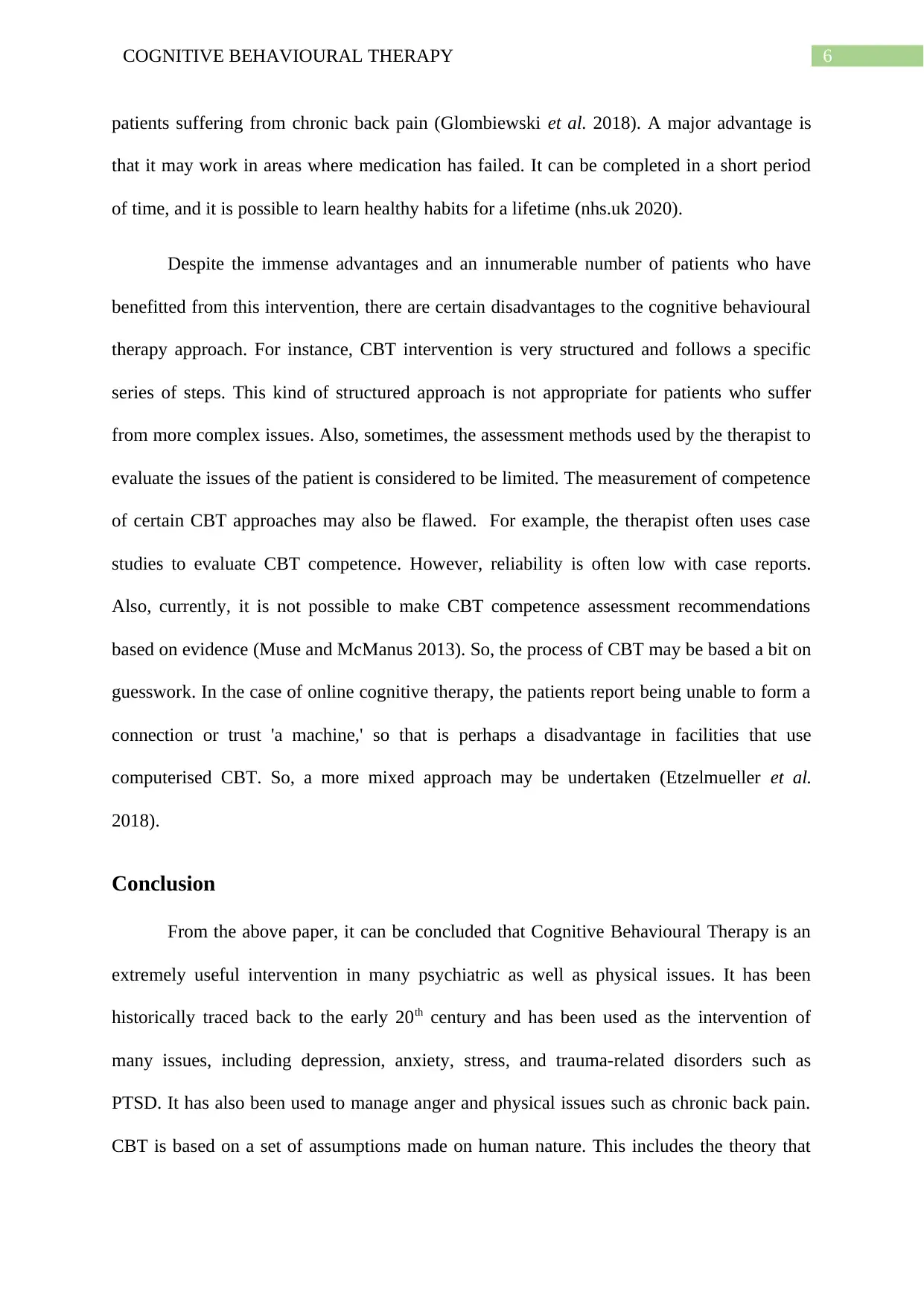
6COGNITIVE BEHAVIOURAL THERAPY
patients suffering from chronic back pain (Glombiewski et al. 2018). A major advantage is
that it may work in areas where medication has failed. It can be completed in a short period
of time, and it is possible to learn healthy habits for a lifetime (nhs.uk 2020).
Despite the immense advantages and an innumerable number of patients who have
benefitted from this intervention, there are certain disadvantages to the cognitive behavioural
therapy approach. For instance, CBT intervention is very structured and follows a specific
series of steps. This kind of structured approach is not appropriate for patients who suffer
from more complex issues. Also, sometimes, the assessment methods used by the therapist to
evaluate the issues of the patient is considered to be limited. The measurement of competence
of certain CBT approaches may also be flawed. For example, the therapist often uses case
studies to evaluate CBT competence. However, reliability is often low with case reports.
Also, currently, it is not possible to make CBT competence assessment recommendations
based on evidence (Muse and McManus 2013). So, the process of CBT may be based a bit on
guesswork. In the case of online cognitive therapy, the patients report being unable to form a
connection or trust 'a machine,' so that is perhaps a disadvantage in facilities that use
computerised CBT. So, a more mixed approach may be undertaken (Etzelmueller et al.
2018).
Conclusion
From the above paper, it can be concluded that Cognitive Behavioural Therapy is an
extremely useful intervention in many psychiatric as well as physical issues. It has been
historically traced back to the early 20th century and has been used as the intervention of
many issues, including depression, anxiety, stress, and trauma-related disorders such as
PTSD. It has also been used to manage anger and physical issues such as chronic back pain.
CBT is based on a set of assumptions made on human nature. This includes the theory that
patients suffering from chronic back pain (Glombiewski et al. 2018). A major advantage is
that it may work in areas where medication has failed. It can be completed in a short period
of time, and it is possible to learn healthy habits for a lifetime (nhs.uk 2020).
Despite the immense advantages and an innumerable number of patients who have
benefitted from this intervention, there are certain disadvantages to the cognitive behavioural
therapy approach. For instance, CBT intervention is very structured and follows a specific
series of steps. This kind of structured approach is not appropriate for patients who suffer
from more complex issues. Also, sometimes, the assessment methods used by the therapist to
evaluate the issues of the patient is considered to be limited. The measurement of competence
of certain CBT approaches may also be flawed. For example, the therapist often uses case
studies to evaluate CBT competence. However, reliability is often low with case reports.
Also, currently, it is not possible to make CBT competence assessment recommendations
based on evidence (Muse and McManus 2013). So, the process of CBT may be based a bit on
guesswork. In the case of online cognitive therapy, the patients report being unable to form a
connection or trust 'a machine,' so that is perhaps a disadvantage in facilities that use
computerised CBT. So, a more mixed approach may be undertaken (Etzelmueller et al.
2018).
Conclusion
From the above paper, it can be concluded that Cognitive Behavioural Therapy is an
extremely useful intervention in many psychiatric as well as physical issues. It has been
historically traced back to the early 20th century and has been used as the intervention of
many issues, including depression, anxiety, stress, and trauma-related disorders such as
PTSD. It has also been used to manage anger and physical issues such as chronic back pain.
CBT is based on a set of assumptions made on human nature. This includes the theory that
Paraphrase This Document
Need a fresh take? Get an instant paraphrase of this document with our AI Paraphraser
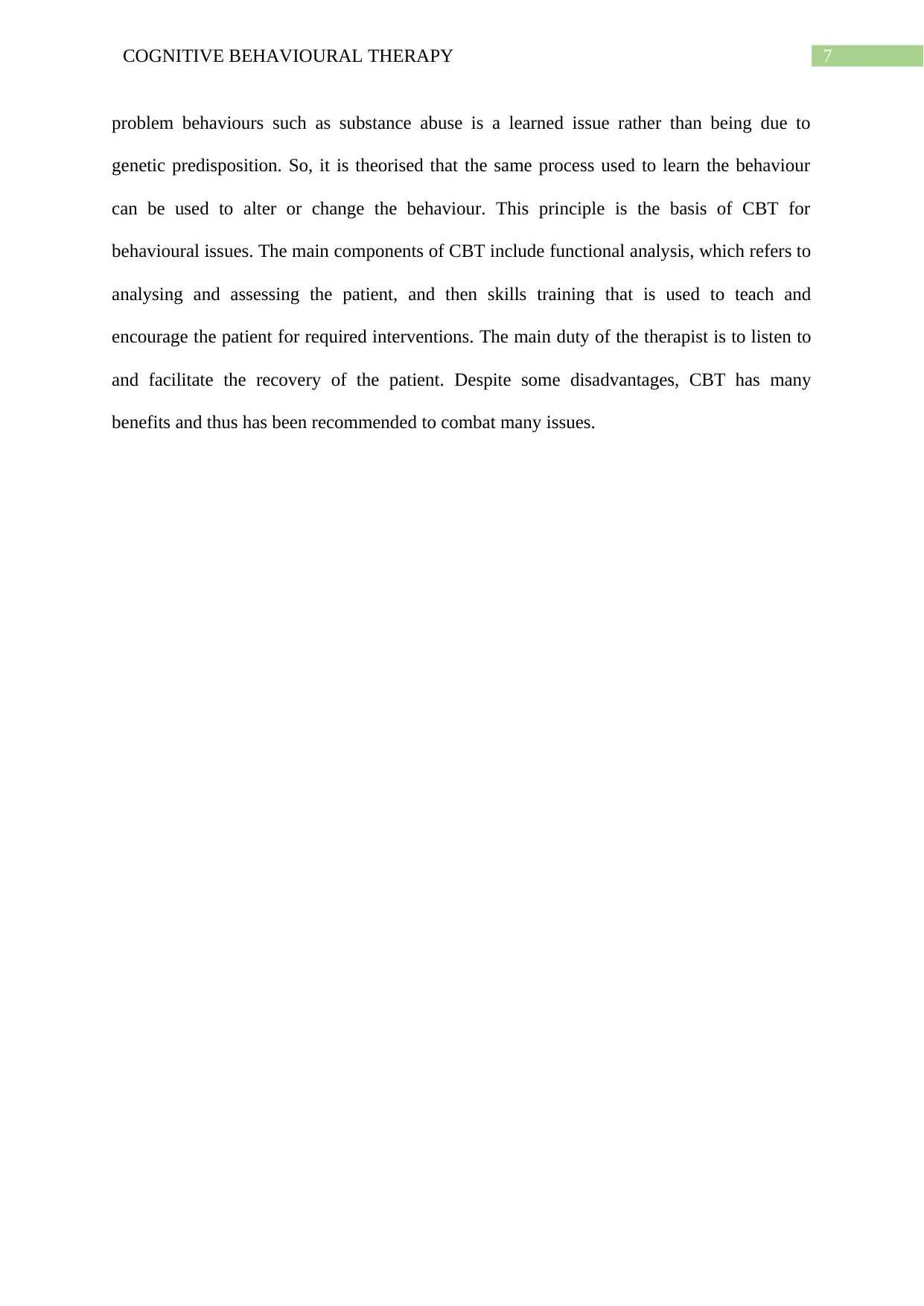
7COGNITIVE BEHAVIOURAL THERAPY
problem behaviours such as substance abuse is a learned issue rather than being due to
genetic predisposition. So, it is theorised that the same process used to learn the behaviour
can be used to alter or change the behaviour. This principle is the basis of CBT for
behavioural issues. The main components of CBT include functional analysis, which refers to
analysing and assessing the patient, and then skills training that is used to teach and
encourage the patient for required interventions. The main duty of the therapist is to listen to
and facilitate the recovery of the patient. Despite some disadvantages, CBT has many
benefits and thus has been recommended to combat many issues.
problem behaviours such as substance abuse is a learned issue rather than being due to
genetic predisposition. So, it is theorised that the same process used to learn the behaviour
can be used to alter or change the behaviour. This principle is the basis of CBT for
behavioural issues. The main components of CBT include functional analysis, which refers to
analysing and assessing the patient, and then skills training that is used to teach and
encourage the patient for required interventions. The main duty of the therapist is to listen to
and facilitate the recovery of the patient. Despite some disadvantages, CBT has many
benefits and thus has been recommended to combat many issues.
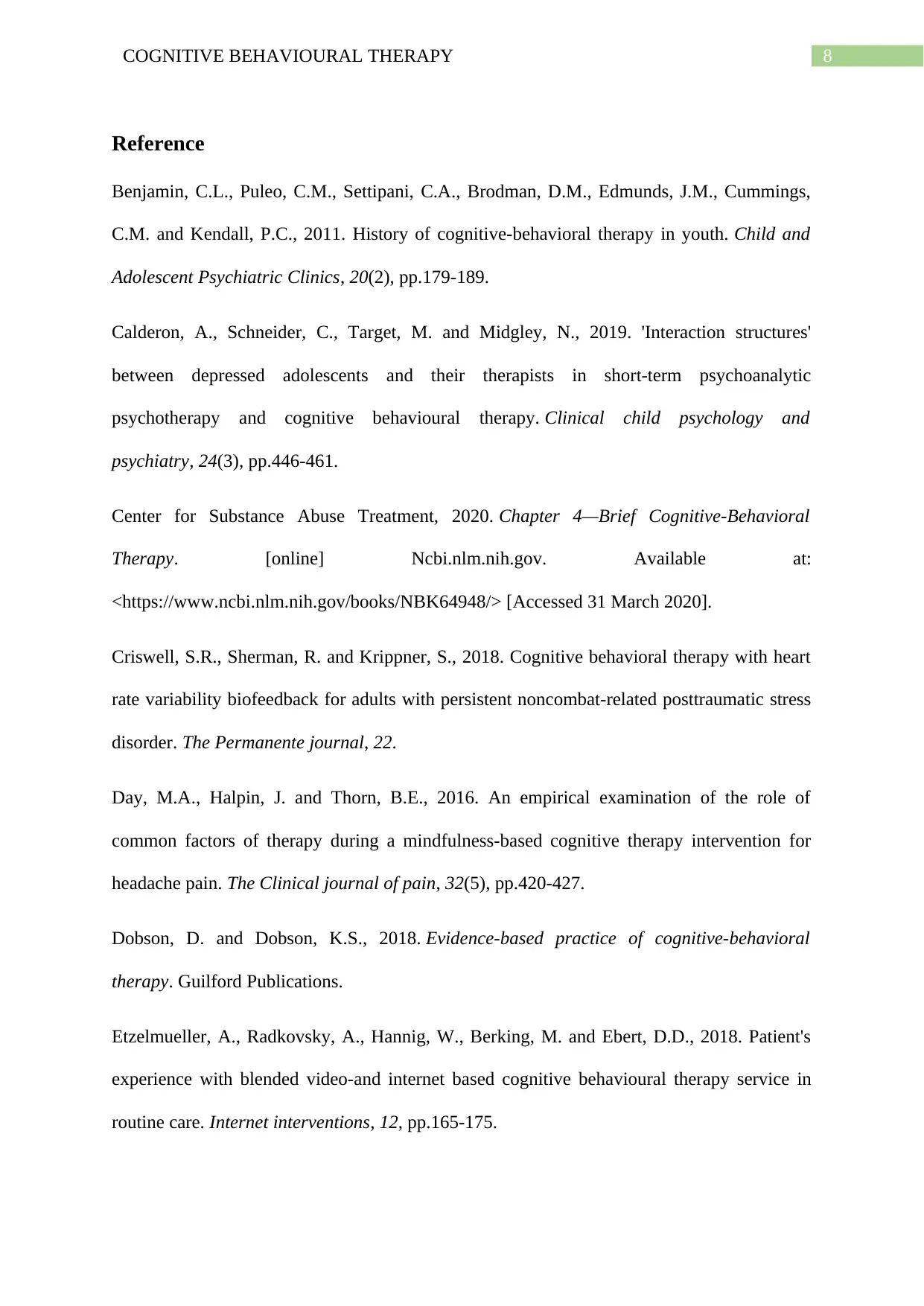
8COGNITIVE BEHAVIOURAL THERAPY
Reference
Benjamin, C.L., Puleo, C.M., Settipani, C.A., Brodman, D.M., Edmunds, J.M., Cummings,
C.M. and Kendall, P.C., 2011. History of cognitive-behavioral therapy in youth. Child and
Adolescent Psychiatric Clinics, 20(2), pp.179-189.
Calderon, A., Schneider, C., Target, M. and Midgley, N., 2019. 'Interaction structures'
between depressed adolescents and their therapists in short-term psychoanalytic
psychotherapy and cognitive behavioural therapy. Clinical child psychology and
psychiatry, 24(3), pp.446-461.
Center for Substance Abuse Treatment, 2020. Chapter 4—Brief Cognitive-Behavioral
Therapy. [online] Ncbi.nlm.nih.gov. Available at:
<https://www.ncbi.nlm.nih.gov/books/NBK64948/> [Accessed 31 March 2020].
Criswell, S.R., Sherman, R. and Krippner, S., 2018. Cognitive behavioral therapy with heart
rate variability biofeedback for adults with persistent noncombat-related posttraumatic stress
disorder. The Permanente journal, 22.
Day, M.A., Halpin, J. and Thorn, B.E., 2016. An empirical examination of the role of
common factors of therapy during a mindfulness-based cognitive therapy intervention for
headache pain. The Clinical journal of pain, 32(5), pp.420-427.
Dobson, D. and Dobson, K.S., 2018. Evidence-based practice of cognitive-behavioral
therapy. Guilford Publications.
Etzelmueller, A., Radkovsky, A., Hannig, W., Berking, M. and Ebert, D.D., 2018. Patient's
experience with blended video-and internet based cognitive behavioural therapy service in
routine care. Internet interventions, 12, pp.165-175.
Reference
Benjamin, C.L., Puleo, C.M., Settipani, C.A., Brodman, D.M., Edmunds, J.M., Cummings,
C.M. and Kendall, P.C., 2011. History of cognitive-behavioral therapy in youth. Child and
Adolescent Psychiatric Clinics, 20(2), pp.179-189.
Calderon, A., Schneider, C., Target, M. and Midgley, N., 2019. 'Interaction structures'
between depressed adolescents and their therapists in short-term psychoanalytic
psychotherapy and cognitive behavioural therapy. Clinical child psychology and
psychiatry, 24(3), pp.446-461.
Center for Substance Abuse Treatment, 2020. Chapter 4—Brief Cognitive-Behavioral
Therapy. [online] Ncbi.nlm.nih.gov. Available at:
<https://www.ncbi.nlm.nih.gov/books/NBK64948/> [Accessed 31 March 2020].
Criswell, S.R., Sherman, R. and Krippner, S., 2018. Cognitive behavioral therapy with heart
rate variability biofeedback for adults with persistent noncombat-related posttraumatic stress
disorder. The Permanente journal, 22.
Day, M.A., Halpin, J. and Thorn, B.E., 2016. An empirical examination of the role of
common factors of therapy during a mindfulness-based cognitive therapy intervention for
headache pain. The Clinical journal of pain, 32(5), pp.420-427.
Dobson, D. and Dobson, K.S., 2018. Evidence-based practice of cognitive-behavioral
therapy. Guilford Publications.
Etzelmueller, A., Radkovsky, A., Hannig, W., Berking, M. and Ebert, D.D., 2018. Patient's
experience with blended video-and internet based cognitive behavioural therapy service in
routine care. Internet interventions, 12, pp.165-175.
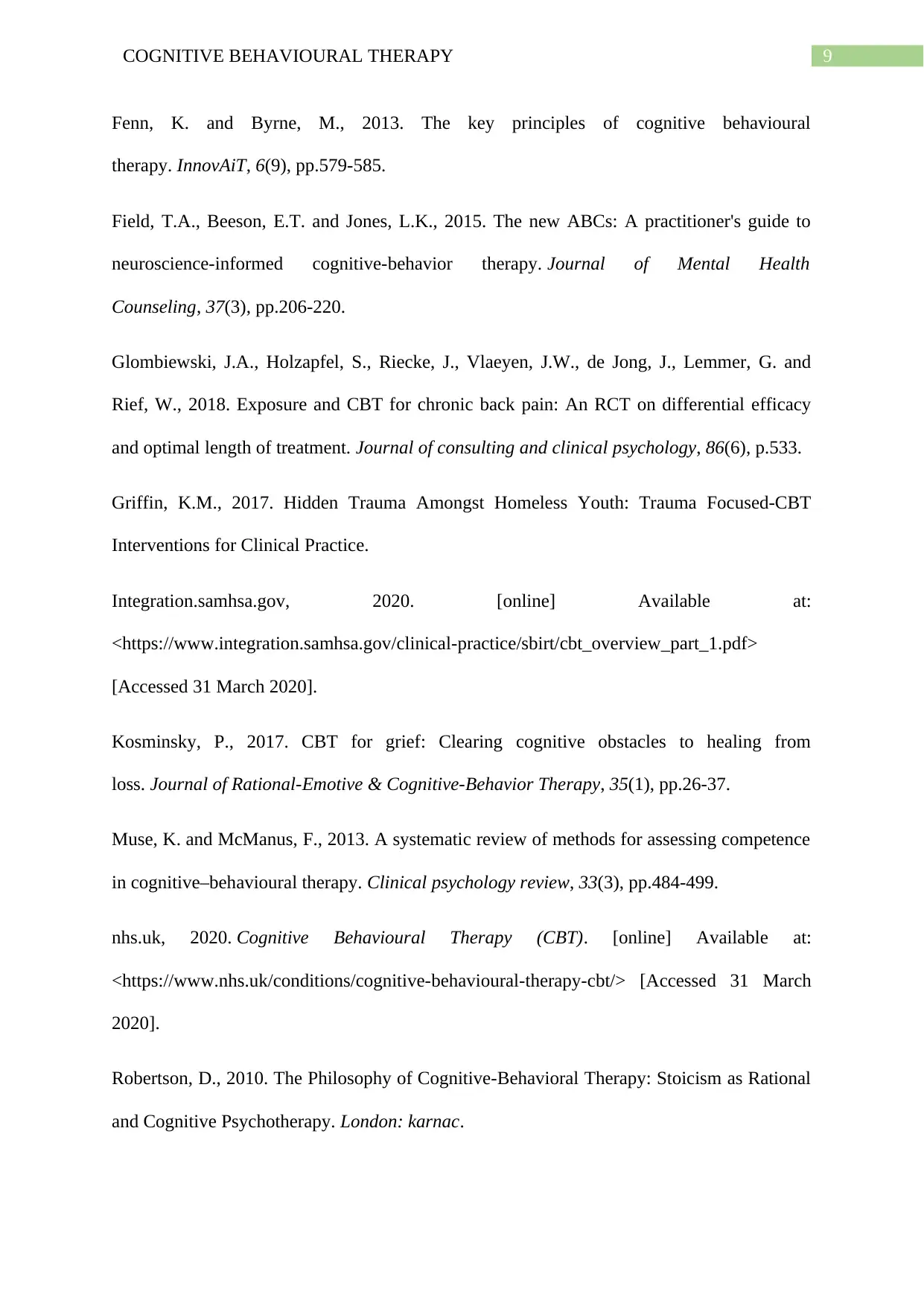
9COGNITIVE BEHAVIOURAL THERAPY
Fenn, K. and Byrne, M., 2013. The key principles of cognitive behavioural
therapy. InnovAiT, 6(9), pp.579-585.
Field, T.A., Beeson, E.T. and Jones, L.K., 2015. The new ABCs: A practitioner's guide to
neuroscience-informed cognitive-behavior therapy. Journal of Mental Health
Counseling, 37(3), pp.206-220.
Glombiewski, J.A., Holzapfel, S., Riecke, J., Vlaeyen, J.W., de Jong, J., Lemmer, G. and
Rief, W., 2018. Exposure and CBT for chronic back pain: An RCT on differential efficacy
and optimal length of treatment. Journal of consulting and clinical psychology, 86(6), p.533.
Griffin, K.M., 2017. Hidden Trauma Amongst Homeless Youth: Trauma Focused-CBT
Interventions for Clinical Practice.
Integration.samhsa.gov, 2020. [online] Available at:
<https://www.integration.samhsa.gov/clinical-practice/sbirt/cbt_overview_part_1.pdf>
[Accessed 31 March 2020].
Kosminsky, P., 2017. CBT for grief: Clearing cognitive obstacles to healing from
loss. Journal of Rational-Emotive & Cognitive-Behavior Therapy, 35(1), pp.26-37.
Muse, K. and McManus, F., 2013. A systematic review of methods for assessing competence
in cognitive–behavioural therapy. Clinical psychology review, 33(3), pp.484-499.
nhs.uk, 2020. Cognitive Behavioural Therapy (CBT). [online] Available at:
<https://www.nhs.uk/conditions/cognitive-behavioural-therapy-cbt/> [Accessed 31 March
2020].
Robertson, D., 2010. The Philosophy of Cognitive-Behavioral Therapy: Stoicism as Rational
and Cognitive Psychotherapy. London: karnac.
Fenn, K. and Byrne, M., 2013. The key principles of cognitive behavioural
therapy. InnovAiT, 6(9), pp.579-585.
Field, T.A., Beeson, E.T. and Jones, L.K., 2015. The new ABCs: A practitioner's guide to
neuroscience-informed cognitive-behavior therapy. Journal of Mental Health
Counseling, 37(3), pp.206-220.
Glombiewski, J.A., Holzapfel, S., Riecke, J., Vlaeyen, J.W., de Jong, J., Lemmer, G. and
Rief, W., 2018. Exposure and CBT for chronic back pain: An RCT on differential efficacy
and optimal length of treatment. Journal of consulting and clinical psychology, 86(6), p.533.
Griffin, K.M., 2017. Hidden Trauma Amongst Homeless Youth: Trauma Focused-CBT
Interventions for Clinical Practice.
Integration.samhsa.gov, 2020. [online] Available at:
<https://www.integration.samhsa.gov/clinical-practice/sbirt/cbt_overview_part_1.pdf>
[Accessed 31 March 2020].
Kosminsky, P., 2017. CBT for grief: Clearing cognitive obstacles to healing from
loss. Journal of Rational-Emotive & Cognitive-Behavior Therapy, 35(1), pp.26-37.
Muse, K. and McManus, F., 2013. A systematic review of methods for assessing competence
in cognitive–behavioural therapy. Clinical psychology review, 33(3), pp.484-499.
nhs.uk, 2020. Cognitive Behavioural Therapy (CBT). [online] Available at:
<https://www.nhs.uk/conditions/cognitive-behavioural-therapy-cbt/> [Accessed 31 March
2020].
Robertson, D., 2010. The Philosophy of Cognitive-Behavioral Therapy: Stoicism as Rational
and Cognitive Psychotherapy. London: karnac.
Secure Best Marks with AI Grader
Need help grading? Try our AI Grader for instant feedback on your assignments.
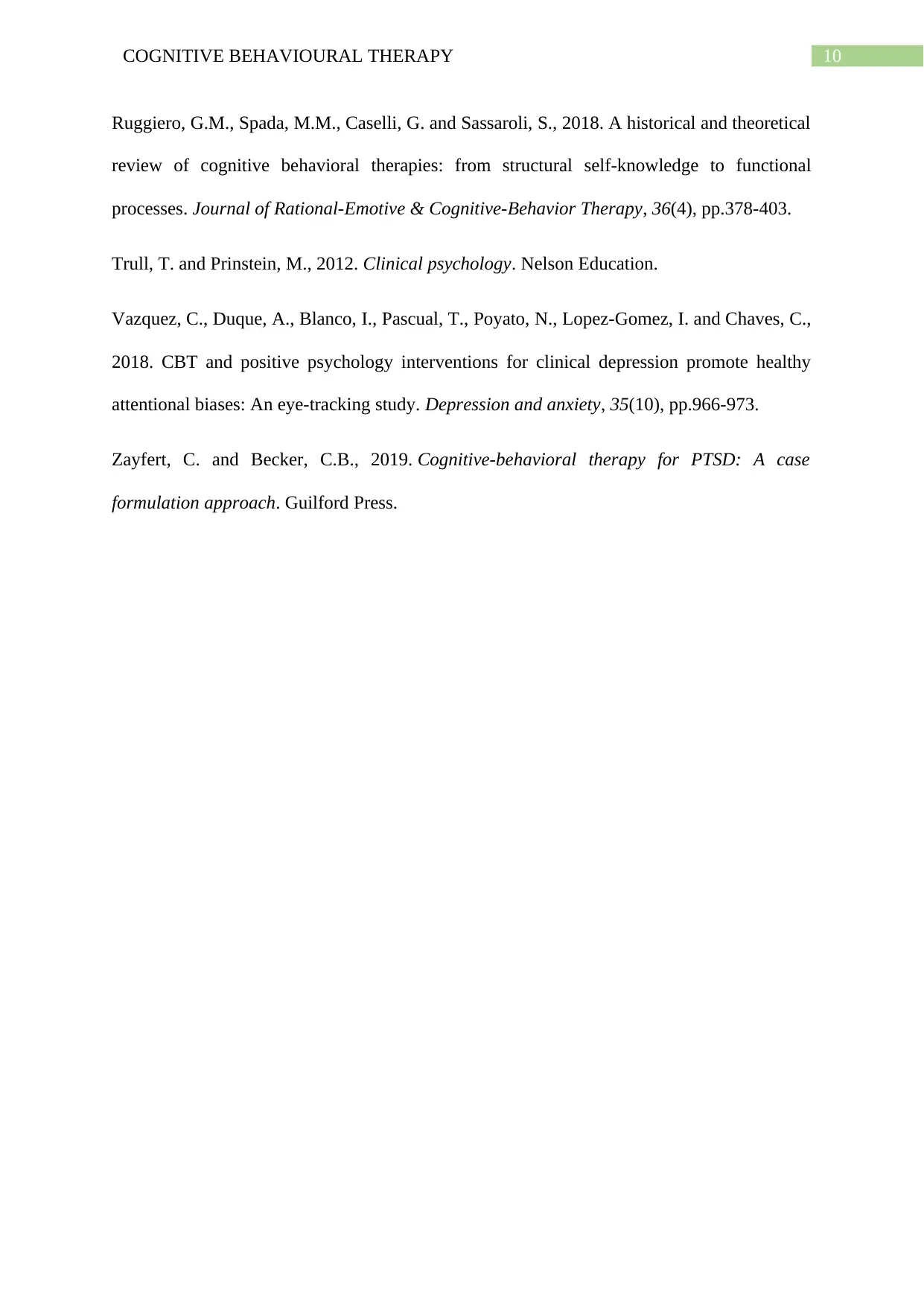
10COGNITIVE BEHAVIOURAL THERAPY
Ruggiero, G.M., Spada, M.M., Caselli, G. and Sassaroli, S., 2018. A historical and theoretical
review of cognitive behavioral therapies: from structural self-knowledge to functional
processes. Journal of Rational-Emotive & Cognitive-Behavior Therapy, 36(4), pp.378-403.
Trull, T. and Prinstein, M., 2012. Clinical psychology. Nelson Education.
Vazquez, C., Duque, A., Blanco, I., Pascual, T., Poyato, N., Lopez‐Gomez, I. and Chaves, C.,
2018. CBT and positive psychology interventions for clinical depression promote healthy
attentional biases: An eye‐tracking study. Depression and anxiety, 35(10), pp.966-973.
Zayfert, C. and Becker, C.B., 2019. Cognitive-behavioral therapy for PTSD: A case
formulation approach. Guilford Press.
Ruggiero, G.M., Spada, M.M., Caselli, G. and Sassaroli, S., 2018. A historical and theoretical
review of cognitive behavioral therapies: from structural self-knowledge to functional
processes. Journal of Rational-Emotive & Cognitive-Behavior Therapy, 36(4), pp.378-403.
Trull, T. and Prinstein, M., 2012. Clinical psychology. Nelson Education.
Vazquez, C., Duque, A., Blanco, I., Pascual, T., Poyato, N., Lopez‐Gomez, I. and Chaves, C.,
2018. CBT and positive psychology interventions for clinical depression promote healthy
attentional biases: An eye‐tracking study. Depression and anxiety, 35(10), pp.966-973.
Zayfert, C. and Becker, C.B., 2019. Cognitive-behavioral therapy for PTSD: A case
formulation approach. Guilford Press.
1 out of 11
Related Documents
Your All-in-One AI-Powered Toolkit for Academic Success.
+13062052269
info@desklib.com
Available 24*7 on WhatsApp / Email
![[object Object]](/_next/static/media/star-bottom.7253800d.svg)
Unlock your academic potential
© 2024 | Zucol Services PVT LTD | All rights reserved.





